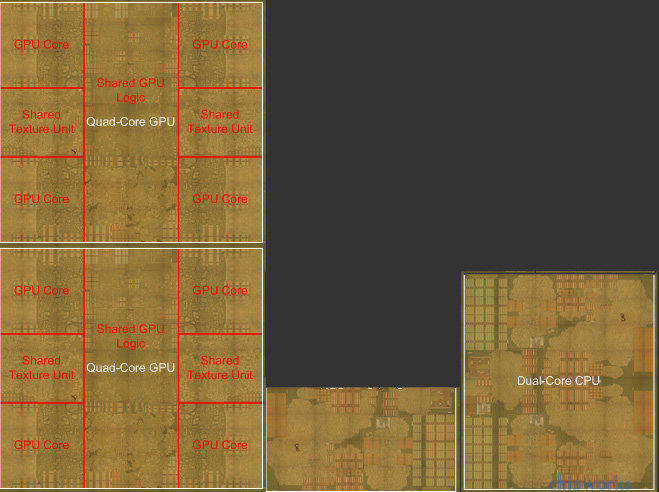Apple appears to have moved to a semi-custom design for the graphics processor in its new A8X SoC while employing an unusual triple-core CPU, according to a new analysis of the chip that powers the iPad Air 2.
The A8X's 8-core GPU is not an off-the-shelf part from longtime partner Imagination Technologies —  which has not yet released such a part —  but instead seems to be a bespoke design that essentially combines two of Imagination's 4-core GX6450 GPUs. The new design was discovered by AnandTech.
Apple is a minority investor in Imagination and licenses their GPU designs, similar to the Cupertino company's arrangement with semiconductor firm ARM, which allows them to create customized versions of the parts for inclusion in the A-series chips.
In addition to the custom GPU, the A8X was found to contain only three physical CPU cores. Its tri-core design was already known, but many previously speculated that it may be a conventional quad-core design with one core simply disabled.
In addition to the extra GPU and CPU cores, the A8X contains approximately 1 billion more transistors than the A8 that powers the iPhone 6 series. The company also doubled the processor's L2 cache to 2 megabytes, increased the clock speed to 1.5 gigahertz, and moved to a 128-bit wide memory bus.
 AppleInsider Staff
AppleInsider Staff








 Charles Martin
Charles Martin
 Christine McKee
Christine McKee
 Wesley Hilliard
Wesley Hilliard
 Malcolm Owen
Malcolm Owen
 Andrew Orr
Andrew Orr
 William Gallagher
William Gallagher
 Sponsored Content
Sponsored Content








48 Comments
This doesn't mean much to the average users.
Are the people who care about these chip specs competitors and investors, or just fans of chip design?
This doesn't mean much to the average users.
The average person doesn't have to know or even care about chip design, but the average person definitely notices that when they use an iPad Air 2, that it's screaming fast, and that's what counts.
I know what you are saying but I think it does - this information tells me that this CPU is way overkill for this current Ipad and therefore it will supported for the next 4-6 OS releases.
Before they kill support for the A8X - Apple will need to retire the A5, A6, A7 and A8 - unlikely since they are still selling A5 devices on 2014.
This doesn't mean much to the average users.
The terminology doesn't, but the user experience it affords, when connected with iOS, does.
So Apple's processor design actually means everything.
For a good dose of meaning, look no further than the astronomical levels of consumer satisfaction, sustained, unremitting interest in iDevices year after year, and the unprecedented mindshare that Apple commands with their products.
User Experience is all.